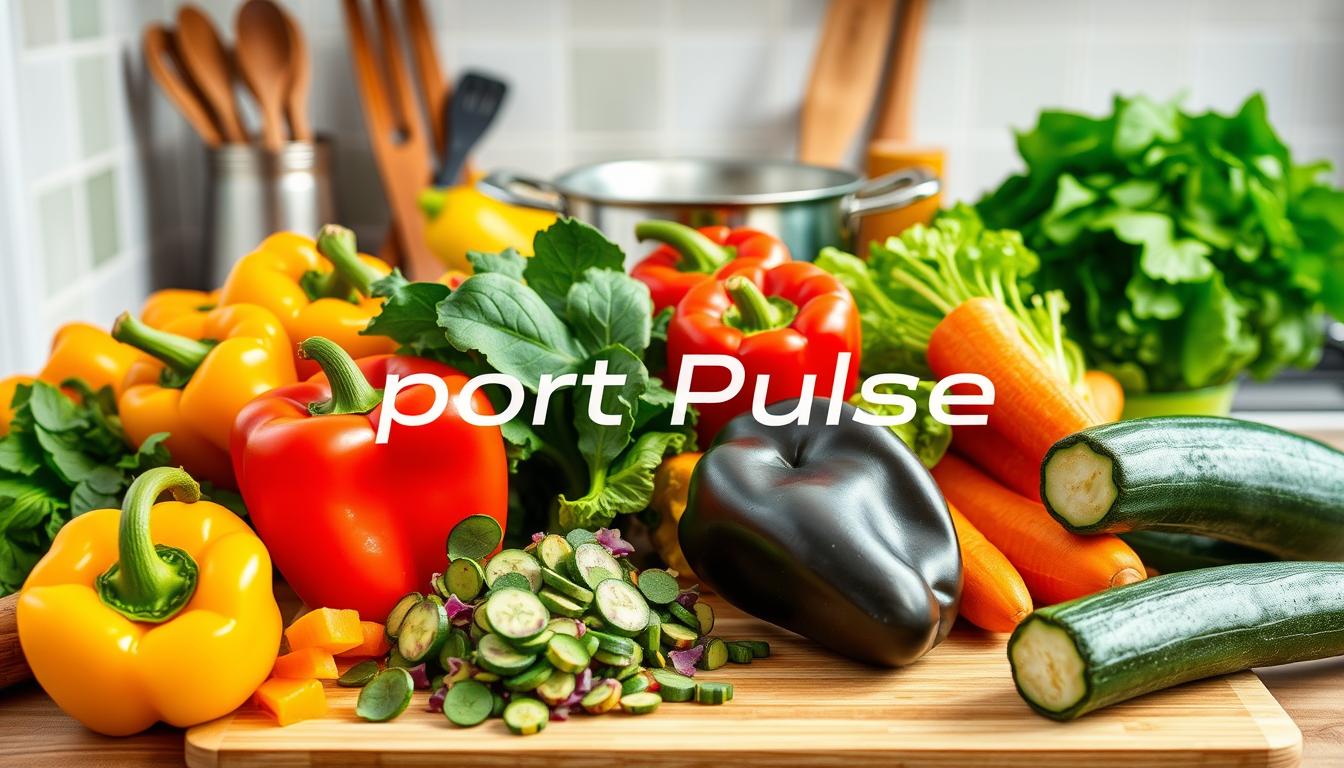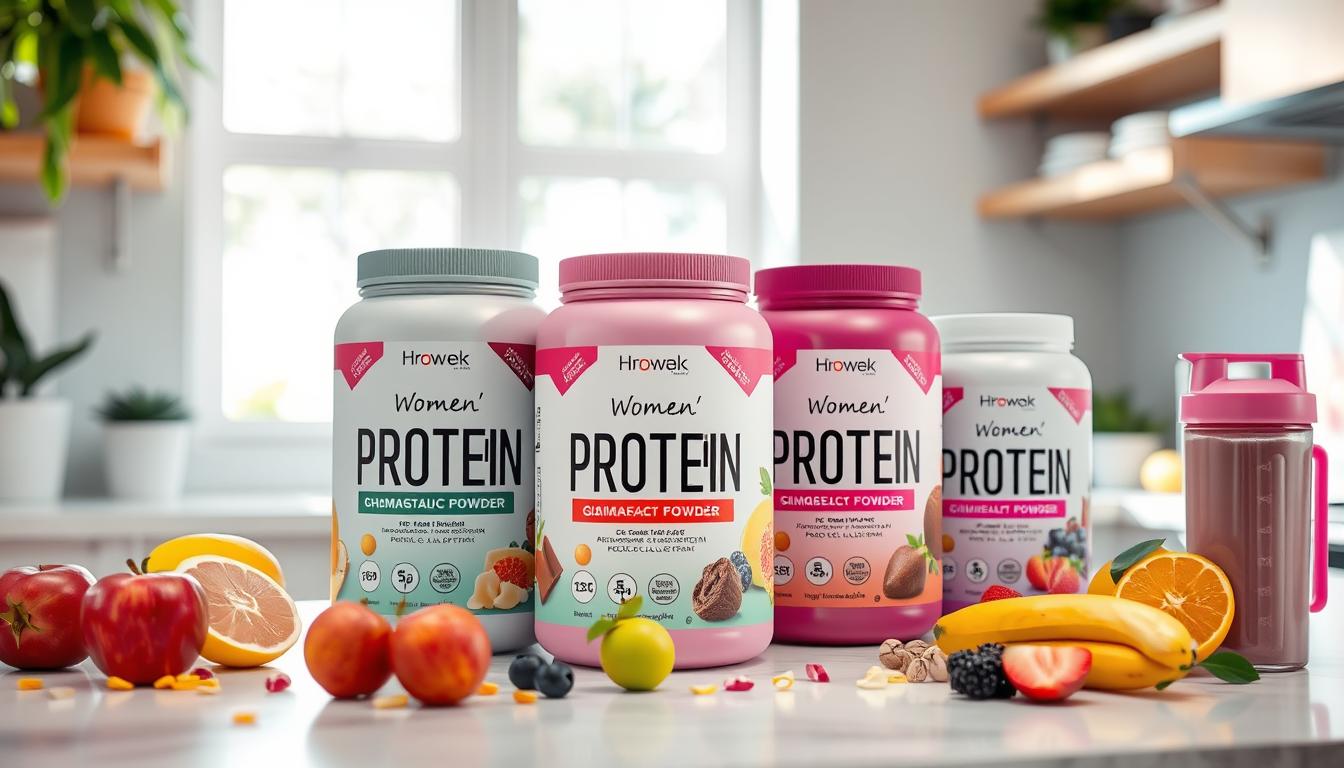We can make our diet much better by eating more vegetables. It’s easy to add veggies to our meals with a bit of creativity. Start with breakfast by making veggie omelets or savory oatmeal.
Adding lettuce wraps to our favorite dishes is another simple way to increase veggie intake. Each lettuce leaf has about 1 calorie. Healthy meal tips also suggest using veggies like zucchini, carrots, and sweet potatoes instead of high-carb foods.
Key Takeaways
- Health authorities recommend consuming several servings of vegetables each day for individual health needs.
- Easy ways to add vegetables to our diet include making veggie omelets or savory oatmeal for breakfast.
- Tips for incorporating more veggies into our meals suggest using lettuce wraps, which contain approximately 1 calorie per leaf.
- Healthy veggie meal tips recommend using vegetables like zucchini, carrots, and sweet potatoes as low-carb substitutes.
- The American Heart Association recommends filling half our plate with fruits and vegetables to meet daily goals.
- Adding more vegetables to our meals can significantly enhance our diet’s nutritional value and provide essential vitamins, minerals, and antioxidants.
- Incorporating plant-based dishes, like Meatless Mondays, can help build a sustainable habit of increased vegetable intake.
Understanding the Importance of Vegetables
We often hear about the importance of vegetables in our diet. But do we really understand their significance? Vegetables are full of nutrients like vitamins, minerals, and antioxidants. These are key for keeping us healthy.
They help prevent chronic diseases and aid in weight management. This is because they are low in calories but high in fiber.
According to the CDC, only about 10% of adults eat enough vegetables each day. This is a worrying fact. Vegetables help lower the risk of heart disease, type 2 diabetes, and obesity. The fiber in them improves digestion, lowers cholesterol, and helps control sugar levels.
Nutritional Benefits of Vegetables
Vegetables offer many nutritional benefits. Here are some:
- High in fiber, which aids in weight management and improves digestion
- Rich in antioxidants, which can reduce chronic disease risks
- Good source of essential vitamins and minerals, like vitamin C and potassium
Impact on Overall Health
The impact of vegetables on our health is huge. Eating them regularly can lower heart disease, type 2 diabetes, and cancer risks. They also boost brain function and reduce neurodegenerative disease risks.
Role in Weight Management
Vegetables are key for weight management. They are low in calories but high in fiber. This makes them perfect for a weight loss diet.
Healthy veggie meal tips include adding them to meals and snacks. Try new recipes like roasting or grilling vegetables. Add them to soups and stews too.
By eating more vegetables, we can improve our health and lower disease risks. With a bit of creativity, we can make our meals and snacks healthier and tastier. This way, we can enjoy the many benefits of a vegetable-rich diet.
| Vegetable | Nutritional Benefits | Healthy Veggie Meal Tips |
|---|---|---|
| Broccoli | High in fiber and antioxidants | Add to soups and stews, or roast as a side dish |
| Spinach | Rich in iron and vitamins | Add to smoothies, or sauté with garlic as a side dish |
| Carrots | High in vitamin A and fiber | Snack on raw carrots, or add to salads and stews |
Creative Ways to Incorporate Vegetables
We can make veggies more appealing by using various cooking techniques. Adding shredded veggies to whole-grain muffins or using them as a base for soups can be both nutritious and tasty. Increasing vegetable intake can be achieved by incorporating them into our meals in creative ways, such as sneaking them into breakfast omelets or making delicious veggie-packed dinners.
Some ways to make veggies more appealing include using frozen mixed vegetables, which can be a simple method to incorporate multiple servings of vegetables in a meal. Weekly meal prep, such as baking multiple sweet potatoes, can facilitate daily consumption of vegetables. For more information on easy weight loss strategies, visit easy weight loss strategies for beginners.
Here are some ideas to get you started:
- Add a handful of spinach to your smoothies for an extra nutritional boost
- Use cauliflower as a versatile ingredient, enjoying it in at least 3 different forms
- Presentation matters: presenting roasted vegetables creatively can enhance the likelihood of consumer acceptance
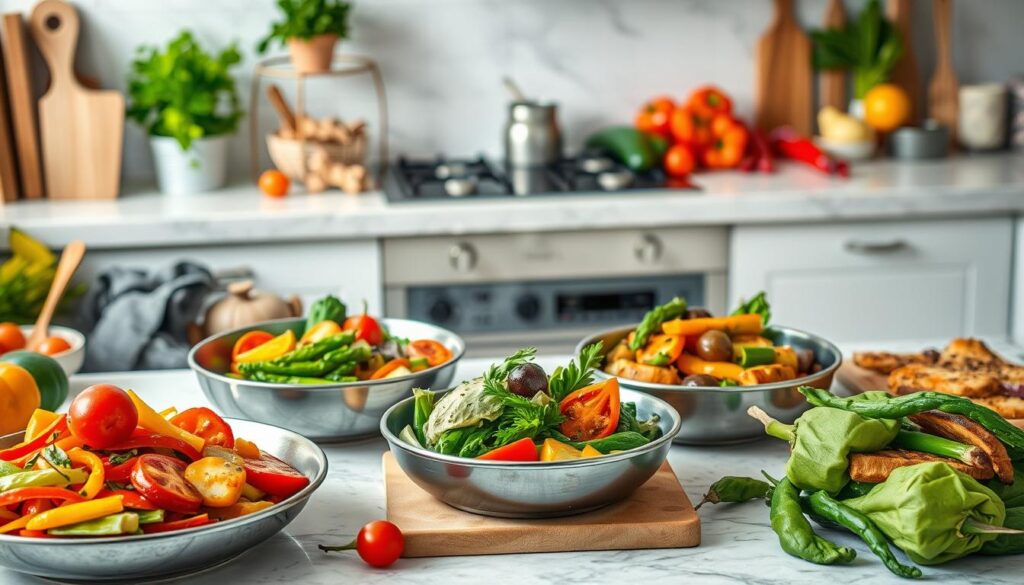
By incorporating veggies into our meals, we can lower the risk of chronic diseases and improve our overall health. So, let’s get creative and make veggies a staple in our diets!
Meal Prep: Making Veggies Convenient
Meal prep is a great way to add more veggies to our diet. By planning meals ahead, we can always have healthy options ready. It’s easy to prep veggies like omelet fillings or roasted vegetables for the week.
Meal prep also helps reduce food waste. It ensures we use veggies before they go bad. Plus, it saves time during the week. We can quickly grab our prepped veggies and go.
Here are some meal prep tips:
- Prep a variety of veggies, like broccoli, carrots, and bell peppers, to keep things interesting
- Use airtight containers to store prepped veggies and keep them fresh
- Consider roasting or grilling vegetables in advance to add flavor and texture
By adding veggie meal planning to our routine, healthy eating becomes easier. With a bit of planning and prep, we can enjoy
| Vegetable | Prep Time | Storage Life |
|---|---|---|
| Broccoli | 10 minutes | 5 days |
| Carrots | 5 minutes | 7 days |
| Bell Peppers | 10 minutes | 5 days |
Exploring Different Cooking Methods
Trying new ways to cook veggies can really change the game. By using different vegetable cooking techniques, we can make veggies more fun to eat. Grilling and roasting are great examples of creative ways to eat more veggies.
Grilling adds a smoky taste to veggies, making them taste better. Roasting, on the other hand, brings out their natural sweetness. By adding these ways to make veggies more appealing to our cooking, we can eat more veggies and enjoy healthy eating more.
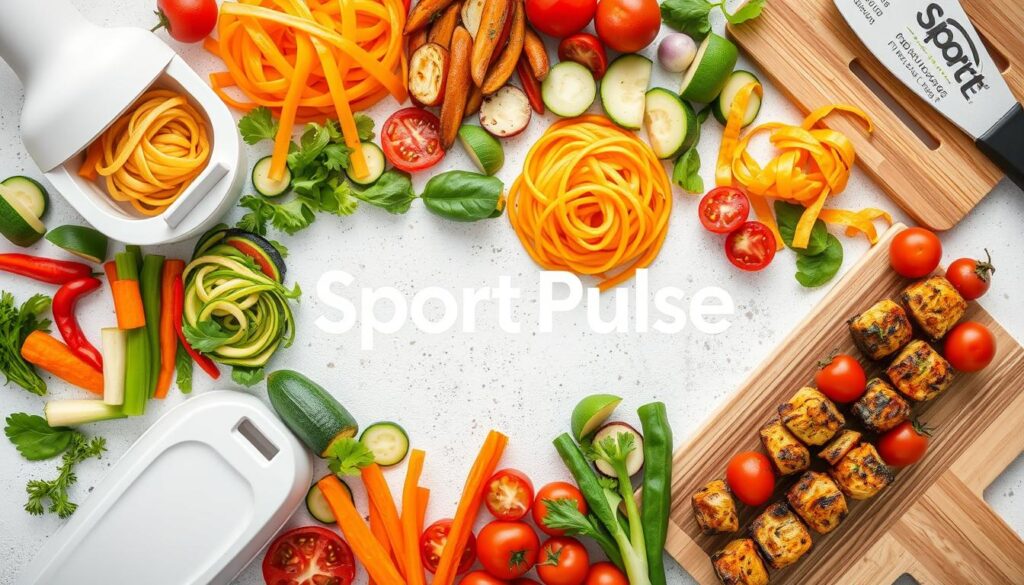
- Grilling: adds a smoky flavor and texture to veggies
- Roasting: brings out the natural sweetness in veggies
- Steaming: preserves the nutrients and color of veggies
Exploring these cooking methods makes veggies more exciting in our meals. It helps us eat more veggies and enjoy healthy eating.
| Cooking Method | Benefits |
|---|---|
| Grilling | Adds smoky flavor and texture |
| Roasting | Brings out natural sweetness |
| Steaming | Preserves nutrients and color |
Engaging the Whole Family in Veggie Consumption
We can make mealtime fun for kids by letting them help with meal prep. This can make them more willing to try new delicious vegetable dishes. By getting kids involved in veggie meal planning, we help them start healthy eating habits early.
Here are some ways to get the whole family involved in eating veggies:
- Let kids help with meal prep, like washing veggies or mixing salads
- Make a veggie meal planning chart together to plan meals for the week
- Try new delicious vegetable dishes together, like roasted veggies or veggie stir-fries
By making mealtime fun and interactive, we encourage kids to try new veggies. It’s as simple as having a “taste test” game or a “veggie of the week” challenge.
| Day | Meal | Vegetables |
|---|---|---|
| Monday | Grilled chicken with roasted vegetables | Broccoli, carrots, bell peppers |
| Tuesday | Veggie stir-fry with brown rice | Spinach, mushrooms, snow peas |
| Wednesday | Lentil soup with a side salad | Lettuce, tomatoes, cucumbers |
Utilizing Seasonal Vegetables
We can make our meals more interesting by using seasonal vegetables. Knowing what’s in season helps us get the freshest produce. For easy ways to add vegetables to your meals, try seasonal veggies in your favorite dishes.
Some healthy veggie meal tips include adding seasonal veggies to soups, salads, and roasted dishes. We can also get creative ways to eat more veggies by trying new recipes and cooking methods. For instance, using veggie puree in soups can boost nutrition and taste.
Here are some benefits of using seasonal vegetables:
- Cost-effective and fresh produce
- Supports local farmers and the local economy
- Encourages creative ways to eat more veggies and try new recipes
By adding seasonal vegetables to our meals, we help our health and the environment. Let’s start exploring the many benefits of using seasonal vegetables in our cooking!
Enhancing Flavor with Herbs and Spices
We can make veggies more tasty by using herbs and spices. Techniques like steaming, roasting, or sautéing help bring out their natural flavors. Adding herbs and spices can make them even more appealing.
Herbs like basil, rosemary, and thyme pair well with veggies. Spices like paprika, cumin, or coriander can add a flavor boost. Simple sauces like hummus or tzatziki can also enhance the taste of our veggie dishes. By trying new ways to make veggies appealing, we can improve our health and wellbeing.
Here are some tips for using herbs and spices to enhance flavor:
- Use fresh herbs for the best taste.
- Try different spice blends to find your favorites.
- Be adventurous with new herbs and spices.
By adding herbs and spices to our cooking, we can make veggies more delicious. Whether we’re roasting, grilling, or sautéing, the right mix can change the flavor of our veggies.
| Herb/Spice | Pairing Suggestions |
|---|---|
| Basil | Tomatoes, bell peppers, eggplant |
| Rosemary | Carrots, potatoes, sweet potatoes |
| Paprika | Broccoli, cauliflower, Brussels sprouts |
Experimenting with Plant-Based Cooking
We can try new ways to eat veggies by adding plant-based meals to our diet. This means trying vegetable recipe ideas like stir-fries, salads, and soups. Plant-based cooking lets us find healthy veggie meal tips that taste great and are good for us.
Some high-protein plant-based foods include:
- Chickpeas (15 grams of protein per cup)
- Soy products (20 grams of protein per cup)
- Quinoa (8 grams of protein per cup)
These foods help us make tasty healthy veggie meal tips and vegetable recipe ideas. This makes it easier to eat more plants.
Adding more plant-based meals to our diet has many benefits. It can lower cholesterol and blood pressure, help us lose weight, and boost our immune system. We can start by having one meat-free day a week and then add more plant-based meals. With a bit of creativity, we can enjoy creative ways to eat more veggies and make plant-based cooking a fun part of our lives.
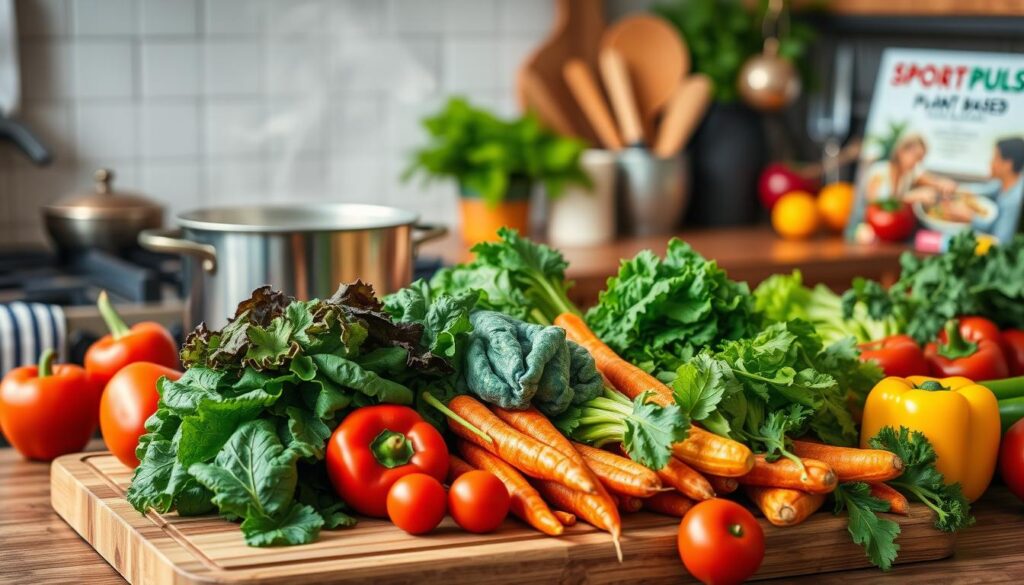
Using Supplements for Nutritional Balance
Trying to eat more veggies is important for our health. Supplements can help make sure we get all the nutrients we need. They can fill in the gaps when veggies alone aren’t enough.
Adding veggies to our meals is easy. We can sneak them into breakfast, add them to lunch, and make dinners full of veggies. By following some simple tips, we can make sure our diet is balanced and full of variety.
Here are some important things to remember about supplements:
- Choose supplements that complement our diet, not replace healthy foods
- Always talk to a healthcare professional before starting any supplements
- Make sure supplements come from trusted sources and meet our dietary needs
Understanding the role of supplements is key. They should help, not take the place of, a diet full of veggies and whole foods. By picking the right supplements, we can make our meals even healthier.
| Supplement | Benefits |
|---|---|
| Vitamin C | Boosts immune system, supports collagen production |
| Probiotics | Supports gut health, aids in digestion |
| Omega-3 fatty acids | Supports heart health, reduces inflammation |
Creating a Garden for Fresh Produce
We can make our diet better by growing our own vegetables. This way, we always have fresh veggies to add to our meals. It makes it easier to eat more vegetables and enjoy tasty dishes.
Home gardening is great for many reasons. We can grow our favorite veggies and use them in many dishes. This helps us plan meals better and reduces food waste.
Benefits of Home Gardening
Home gardening gives us control over what we eat. It also helps us save money and enjoy the calming effects of gardening. Growing our own veggies ensures we always have fresh food, making it easier to eat healthy.
Easy Vegetables to Grow
For beginners, starting with easy veggies like tomatoes, cucumbers, and squash is a good idea. These are tasty and easy to care for. As we get better, we can grow more types of veggies and improve our meal planning.
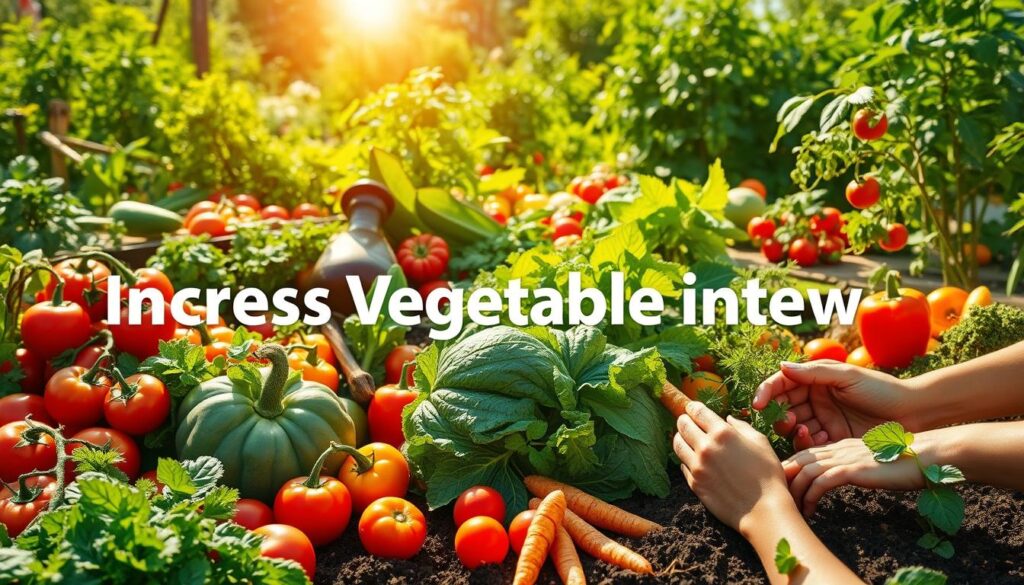
How Gardening Enhances Our Diet
Gardening makes our diet better by giving us fresh, healthy food. With a garden, we can eat a variety of veggies. This helps us eat more whole foods and reach our goal of eating more veggies.
| Vegetable | Days to Maturity | Space Required |
|---|---|---|
| Tomatoes | 60-90 | 3-5 square feet |
| Cucumbers | 50-70 | 5-10 square feet |
| Squash | 35-55 | 5-10 square feet |
Staying Motivated to Eat More Veggies
Eating more veggies is a journey, and staying motivated is key. By setting realistic goals, tracking our progress, and celebrating our achievements, we can keep the enthusiasm for a veggie-packed diet alive. Making veggies fun and tasty, and involving family and friends, makes it more enjoyable and helps us stick to our goals.
Setting Realistic Goals
Start by setting specific, achievable goals for increasing our vegetable intake. Whether it’s aiming to add an extra serving of veggies to our daily meals or trying a new vegetable each week, maintaining a positive and realistic mindset is key. Celebrate small wins along the way, as these milestones can provide the motivation to keep going.
Tracking Our Progress
Monitoring our vegetable consumption can help us stay on track and identify areas for improvement. Apps, food journals, or simple checklists can be effective tools for tracking our daily vegetable intake. Seeing our progress over time can be a powerful source of encouragement to continue our veggie-rich journey.
Celebrating Our Achievements
Remember to pat ourselves on the back for our efforts! Reward yourself with a special meal, a fun activity, or simply the satisfaction of knowing you’re taking steps to improve your health. Sharing your successes with loved ones can also boost your motivation and inspire them to join in the veggie-loving fun.
